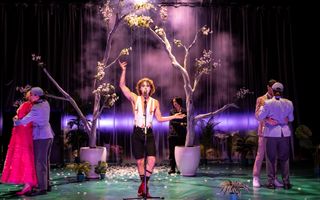Twelfth Night was written around 1601–1602 and had its first public performance on the 2nd of February 1602, in Middle Temple Hall, London, during the celebration of Candlemas.
The play was published in the First Folio of 1623 and was known for being “remarkably clean” (W.W Greg, The Shakespeare First Folio (1955), meaning it was unusually free of misaligning of verse and inconsistent spelling and phrasing, a common issue attributed to the first folio texts. Due to the cleanness with which the text was published, it is often concluded by most academics that Twelfth Night was transcribed directly from Shakespeare’s ‘foul papers’ (an author's original, manuscript drafts).However, the play still contained several misprints which were corrected in the Second Folio edition of 1632.
As with most of Shakespeare’s plays, the inspiration for Twelfth Night sprung from a considered and imaginative combination of other known works, mythical and classical stories, folklore, ceremonies, and Shakespeare’s own body of work. Writers on the topic often attribute the Italian play Gl’ Ingannati (The Deceived Ones), written by the Academy of the Intronati (a literary and scholarly society in Siena) in 1531, as Shakespeare’s greatest inspiration for Twelfth Night. Some debate the link as the play was never translated into English, nor was it ever studied in British schooling, and argue that Shakespeare simply would not have had access to the text. That said, the similarities in plot are certainly hard to argue. A young woman, Lelia, is in love with a young gentleman, Flamminio. Flamminio, in turn, loves another girl, Isabella. Lelia seeks employment as Flamminio’s page and does so by disguising herself as a man and calling herself Fabio. Fabio is charged with delivering love letters to Isabella, from Flamminio, but in a big twist of fate, Isabella falls in love with Fabio (the disguised Lelia). If we were to change those names to Viola, Orsino and Olivia, we would have a skeleton of the narrative that serves as the primary plot of Twelfth Night.
Although remarkably similar to the plot of Twelfth Night, the story of The Deceived Ones does differ on many accounts, and one cannot ignore the years of debate around whether Shakespeare actually had access to the text. Such writers instead look to Barnabe Riche’s prose tale of Apolonius and Silla, within his collection titled Farewell to the Military Profession, published in 1581, which Shakespeare would have certainly read. The story bares the same key narrative points as The Deceived Ones, and takes us closer to Twelfth Night with the addition of a new ending. The way in which the mistaken identity and relationships are mended are almost identical to the final moments of Twelfth Night. Juliana claims that Silvio (a disguised young woman called Silla) and she spent the night together. Shocked, Silvio reveals her true identity as Silla, and professes her love for Apolonius. Apolonius shares the same feeling and they are married. The real Silvio arrives, and he and Juliana are likewise married.
In writing on the topic of historical context and influences, it would be remiss to not mention the play’s title. Throughout the late 16th century, and well into the 17th century, there was a constant idealistic battle between the Puritans (protestants who sought to purify the Church of England) and the rest of society within England, namely Catholics. Puritans were anti-revelry and certainly anti-theatre, with artists being held in the same regard as criminals.This ultimately led to theatres being shut down in 1642. Every year, there was one night of the year in the Catholic calendar that was dedicated to legal disorder, named ‘Twelfth Night’, a night in which Puritans would seek to suppress others. It was an occasion of celebration and revelry. Servants would dress as their masters, men would dress as women and vice versa, and people would parade in the streets, feasting and drinking. This festive and carnivalesque ritual is often regarded as the cultural influence of Shakespeare’s gender-bending plot and certainly parallels closely with the clashing of ideals between Malvolio and Sir Toby Belch, along with his train of revelers. The argument between the two systems of belief is inserted directly into Shakespeare’s text, which would have held a close resonance for his audience. Malvolio says:
My masters, are you mad? or what are you? Have ye
no wit, manners, nor honesty, but to gabble like
tinkers at this time of night? Do ye make a
alehouse of my lady's house...
To which, Sir Toby retorts:
Dost thou think, because thou art virtuous,
there shall be no more cakes and ale?
Act 2, Scene 3
As with many of his plays, Twelfth Night shows us Shakespeare’s skill in being able to adapt a narrative and place the Elizabethan audience right at the centre of the story. Theatre Director and former Artistic Director of the National Theatre (UK), Nicholas Hynter, says of the play, it has ‘unrequited love, melancholy, cruelty and joy held in perfect balance.’





